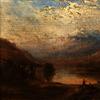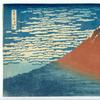A Century of African-American Quilts to be Celebrated in a New Exhibition at The Art Museums of Colonial Williamsburg in Honor of Black History Month, February 2016
- WILLIAMSBURG, Virginia
- /
- December 14, 2015
The lively tradition of quilting in America following the abolition of slavery (from the 1870s to approximately 1990) will be revealed in a new exhibition, A Century of African-American Quilts, which will open on January 30, 2016, and remain on view through January 2, 2018, at the Abby Aldrich Rockefeller Folk Art Museum, one of the Art Museums of Colonial Williamsburg. Freedom from convention sets these examples apart from ordinary, more common place, appliqué and piecing techniques. The exhibition features twelve quilts, six never before exhibited. This show is part of a larger program of activities and special events organized by the Colonial Williamsburg Foundation in celebration of Black History Month in 2016.
“The Colonial Williamsburg Foundation is known for its outstanding collection of British and American quilts, but our growing assemblage of African-American quilts has received relatively little exposure,” said Ronald L. Hurst, the Foundation’s vice president for collections, conservation, and museums and its Carlisle H. Humelsine Chief Curator. “It seems particularly appropriate to share a substantial number of these striking objects in a single showing as we celebrate the historical and cultural contributions of black Americans.”
Depending on the location of the quilter, the purpose for which the quilt was made and the quilter’s personal artistic vision, these African-American-made covers varied widely during the time period explored in A Century of African-American Quilts. Some of the women who made the pieces adapted or were inspired by their Anglo-American neighbors. Others appear to have been guided by their own artistic vision, informed and influenced by their African heritage. An especially unique regional group from the twentieth century represented in the exhibition is those quilts from the Gee’s Bend, Alabama, vicinity. These quilts are renowned for their innovative use of color, pattern, asymmetry and the free adaptation of traditional quilt designs.
Linda Baumgarten, curator of textiles and costumes at Colonial Williamsburg says, “The stunning bedcovers showcase the lively tradition of African-American quilting in the century-and-a-quarter following the abolition of slavery in America. Many of the quilters worked with a freedom from convention that sets their work apart. The exhibition promises to be an exciting visual experience for all of our visitors, not just those who love quilts.”
Among the highlights of the exhibition, is a graphically eye-catching log cabin quilt top, probably made between 1875 and 1900 by the formerly enslaved Anna Jane Parker (Mrs. Charles E. Parker) (b. ca. 1841 in North Carolina), in St. Louis, Missouri. According to Anna Jane’s granddaughter, Helen Edmonia McWorter Simpson, to whom the quilt descended, she worked as a seamstress and “sewed beautifully.” Helen would have seen her grandmother’s craftsmanship first-hand, because Anna Jane lived with Helen, daughter Edmonia and Edmonia’s husband John McWorter after she was widowed. Although it is possible that the quilt could have been made by Edmonia or Helen’s other grandmother, Anna Jane Parker had the sewing skills and access to silk dress materials from her work as a seamstress and is the most likely quilt maker. For this never-before-exhibited quilt, the maker assembled a colorful array of textiles, including patterned dress silks, upholstery fabrics and ribbons, and combined them with black to create a stunning dark and light diamonds design. Typically, Log Cabin quilt pieces are assembled and stitched onto a foundation textile. Here, a wide variety of everyday and mismatched cottons were used to form the foundation, because that element was eventually hidden by the decorative pieces. This quilt remained unfinished without any batting or backing.
Another visually striking quilt to be shown in A Century of African-American Quilts is a star quilt made ca. 1970 by Indiana Bendolph Pettway (1913-1996), who was raised in poverty in Gee’s Bend, Alabama. The quilt makers and their quilts from this isolated community of mostly rural African Americans descended from enslaved families have achieved international acclaim, and this example proves why. A dramatic and unusual choice of black and white with shading from grey to blue for the lone star pattern (the design is more commonly worked in multicolor), Indiana adapted the traditional design. This quilt, based on its faded, stained and mended condition, was clearly functional and well used for many years. Older, printed cotton was used as a filling and can be seen beneath the white areas of relatively thin double knit fabric. A bright, daisy print in yellow, orange, brown and white backs the quilt and forms a narrow finishing edge around the front.
Fascinating use of symbolic images in an appliquéd quilt made by Dora Smith (working ca. 1901) in DeKalb County, Georgia, makes her quilt another highlight of the exhibition. The longtime oral tradition that was passed down with the quilt was that the names appliquéd on it were those of the quilt maker’s children (Liza, Amos, Ruth and Toby), and the initials “DS” are appliquéd on it as well. Although genealogical research reveals several African-American women in Georgia named Dora Smith, none of them located thus far, however, had any children with these names. In addition to the initials and names on the quilt, the maker also included words “CATS,” “DOGS,” “BOYS,” and “GIRL” along with motifs including scissors, a kettle, stars, the moon, crosses, snakes, abstracted human figures, a hand and an eye, all of which were taken from domestic life and the environment.
A new acquisition to the Colonial Williamsburg collection and never before exhibited—a tied quilt made by Susana Allen Hunter (1912-2005)—is another centerpiece of A Century of African-American Quilts. Susana left a legacy of at least 100 artistic quilts and despite her poverty—or perhaps because of it—she expressed herself by making warm, useful quilts for her family, and used whatever fabrics were available to recycle from worn-out denim work clothes to synthetic curtains and dresses. Around 1970, Susana and her husband, Julius, moved to Dallas County, Alabama, where she remained after his death. She eventually moved to Mobile, where she lived until her death in 2005 with her grandson Tommie and his wife, Susie. This tied quilt came from Tommie’s collection. Combining remnants of used clothing, including a grey-blue diamond-pattern polyester dress, tied to the backing with brilliant red yarn knots with long tails left on the front of the quilt, this dynamic design is backed with cut apart and opened, 100-pound sugar and flour sacks.
An appliquéd counterpane made by an unknown quilter in possibly Baltimore or New York State (c. 1920), is a dynamic bedcover attributed to an African-American stitcher, partly because some of the motifs, including a cross, hearts, chickens, human figures and others relate to African textiles. The quilt’s former owner, a prominent scholar of African-American art, has identified African cosmology motifs found in it: the chicken accompanies the soul to the other side, the eight-pointed stars symbolize perfection or God, the short-armed cross appears in art from the Congo and the hearts may refer to memories. The angels beneath the central cross may memorialize two young African-American sisters who died in one of the epidemics of the early twentieth century, and their white faces symbolize the fact that they had died. Made as a collage of cotton and silk fabrics with lace, braids, beads, buttons and window shade pulls, the textiles were fastened to white cotton ground fabric using a variety of stitching methods, including traditional appliqué with slip stitches, calling to mind conventional Baltimore Album Quilts, as well as chain, running stitches and machine stitching. Some of the cotton shapes were gathered prior to being stitched to the ground, which creates texture and depth. Yellow cotton satin backing forms a wide border when brought to the front.
A Century of African-American Quilts is made possible through generous gifts from The Stone Family Fund of Los Angeles, California, and the W.K. Kellogg Foundation of Battle Creek, Michigan.
Not only a celebration of the rich tradition of post-abolition, African-American handcrafts, A Century of African-American Quilts is certain to appeal to quilting and folk art aficionados of all walks of life.
About The Art Museums of Colonial Williamsburg
The Art Museums of Colonial Williamsburg include the Abby Aldrich Rockefeller Folk Art Museum and the DeWitt Wallace Decorative Arts Museum. The Abby Aldrich Rockefeller Folk Art Museum is home to the nation’s premier collection of American folk art, with more than 5,000 folk art objects made during the 18th, 19th and 20th centuries. The DeWitt Wallace Decorative Arts Museum exhibits the best in British and American decorative arts from 1670–1830. The Art Museums of Colonial Williamsburg are located at the intersection of Francis and South Henry Streets in Williamsburg, Va., and are entered through the Public Hospital of 1773. Museum hours from January 4 to March 17, 2016, are 10 a.m. to 5:00 p.m. Sundays through Thursdays and from March 18, 2016, to January 2, 2017, 10:00 a.m. to-7:00 p.m. daily. For museum program information, telephone (757) 220-7724.
About The Colonial Williamsburg Foundation
The Colonial Williamsburg Foundation preserves, restores and operates Virginia’s 18th-century capital of Williamsburg. Innovative and interactive experiences, such as the street theatre Revolutionary City® and the RevQuest: Save the Revolution! series of technology-assisted alternate reality games, highlight the relevance of the American Revolution to contemporary life and the importance of an informed, active citizenry. The Colonial Williamsburg experience includes more than 400 restored or reconstructed original buildings, renowned museums of decorative arts and folk art, extensive educational outreach programs for students and teachers, lodging, culinary options from historic taverns to casual or elegant dining, the Golden Horseshoe Golf Club featuring 45 holes designed by Robert Trent Jones and his son Rees Jones, a full-service spa and fitness center, pools, retail stores and gardens. Philanthropic support and revenue from admissions, products and hospitality operations sustain Colonial Williamsburg’s educational programs and preservation initiatives.
# # #
Contact:
Robyn LiverantRobyn Liverant Public Relations
212.472.6947
robyn@robynliverant.com












100x100_c.jpg)

